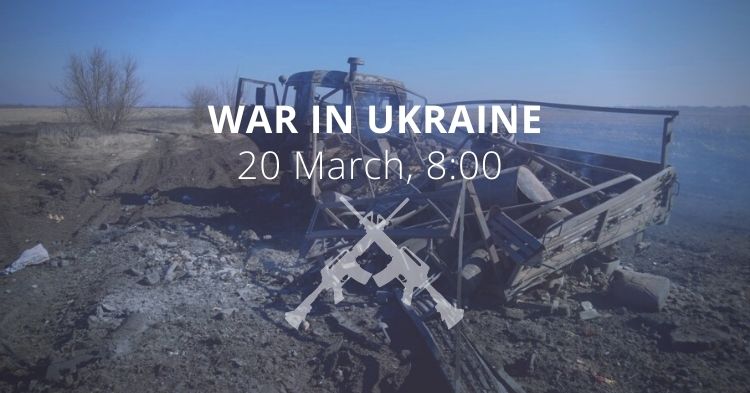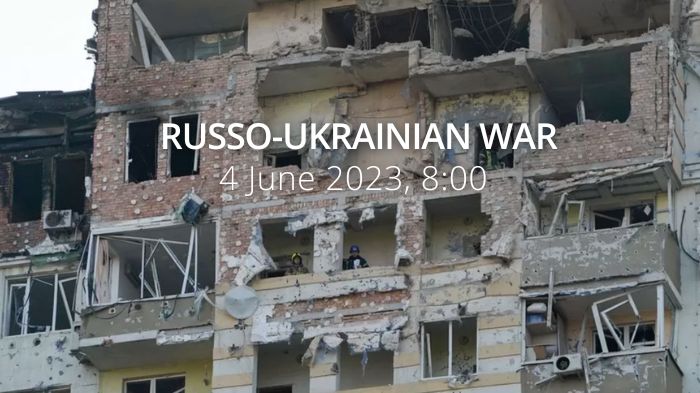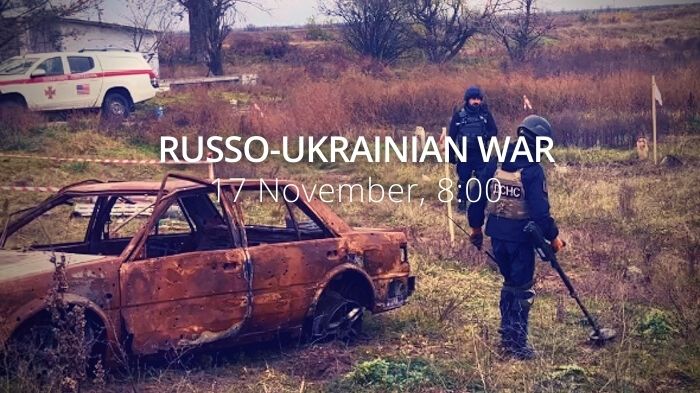The report is based on media reports, expert analyses, and official information posted online as of the morning of 20 March, day 25 of the Russian full-scale invasion of Ukraine.
Situation
According to information from the General Staff as of 06.00 20.03.2022, supplemented by its [noon assessment]:
During the day the enemy did not conduct active offensive operations, focusing on replenishing current losses, restoring partially destroyed equipment, transferring foreign mercenaries to border areas with Ukraine, solving chronic logistics problems of the occupying forces that operating in Ukraine.
[The Ukrainian Defence Forces continues its defense operation in the Eastern, Southeastern, and Northeastern directions. Measures of the martial law regime, stabilization actions, and territorial defense tasks are being carried out.]
[The Air Force of the Armed Forces of Ukraine repulses concentrated missile and airstrikes and air attacks of the enemy, air cover of densely populated cities, important industrial facilities of Ukraine, and troops operational groups.]
[In the southern direction the front line of defense was restored along some borders. In this direction, the enemy is forced to regroup, deploy additional reserves, take measures to restore the combat effectiveness of units.
[In the Donetsk direction Russian occupation forces are conducting assaults and fire.]
[In the Volyn and Polissya direction the enemy did not carry out the active action, building fire control systems, engineering support, and logistics in preparation for the attack on the city of KYIV.]
[Offensive operations are also not underway in the Siverski and Slobozhansky directions. Enemy forces are shelling Ukrainian settlements.]
[In the direction of IZYUM the enemy tried to break through the defenses of our troops but was unsuccessful, the assault units of the invader were actually destroyed.]
[The occupiers suffer significant losses. The moral and psychological condition of the personnel is low and deteriorating with each passing day of hostilities. Punitive units of the Russian National Guard involved in hostilities have lost a significant amount of weapons and military equipment. Recovery of losses is due to outdated and partially defective equipment.]
[The commandant's office of the Russian city Belgorod is investigating a case about 10 servicemen of the 138th Motorized Rifle Brigade who took part in the offensive in Kharkiv and, due to heavy losses, refused to take part in hostilities and incited the rest to return home.]
[It is noteworthy that the head of the 652nd IPSO group of the Russian terrorist forces was severely reprimanded for his weak work on the creation of the so-called "Kherson People's Republic". The Kremlin leadership is not satisfied with the fact that due to popular resistance there is not even a conditional demonstration "picture".]
The occupiers use terrorist methods to impose a brutal administrative and police regime, deliberately creating conditions for a humanitarian crisis in the temporarily occupied territories.
So, last night to the Kherson area from the city of Apostolovo of the Dnipropetrovsk Oblast 14 trucks with foodstuff and medicines of the first necessity had been moved. The Russian occupiers did not give access to a humanitarian convoy for moving without reason.
In this way, occupiers try to force the local population to collaborate. At the same time, the invaders are distributing leaflets with proposals to appeal to the occupation administration, citizens are promised to cancel credit debts, and local entrepreneurs are given preferences in doing business.
It became known that just one serviceman from the combined detachment of the 331st Guards Parachute Landing Kostroma Regiment, which took part in the fighting in the Kyiv direction, survived, and he is in hospital.
Against the background of similar circumstances, the command of the Russian Black Sea Fleet is urgently taking measures to replace 130 defectors-contractors of the 810th Marine Brigade with 7 paratroopers. The FSS decides on their further service.”
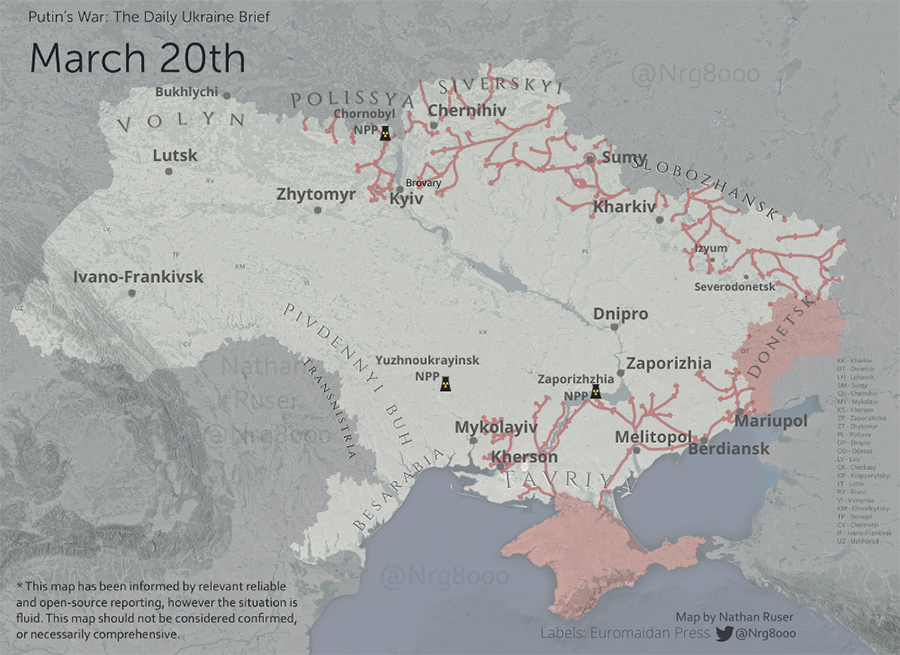
According to British Defence Intelligence, (last 24 hours):
- Russian forces are continuing to encircle a number of cities across eastern Ukraine.
- Over the past week, Russian forces have made limited progress in capturing these cities; instead, Russia has increased its indiscriminate shelling of urban areas resulting in widespread destruction and large numbers of civilian casualties.
- It is likely Russia will continue to use its heavy firepower to support assaults on urban areas as it looks to limit its own already considerable losses, at the cost of further civilian casualties.
- The Ukrainian Air Force and Air Defence Forces are continuing to effectively defend Ukrainian airspace.
- Russia has failed to gain control of the air and is largely relying on stand-off weapons launched from the relative safety of Russian airspace to strike targets within Ukraine.
- Gaining control of the air was one of Russia's principal objectives for the opening days of the conflict and their continued failure to do so has significantly blunted their operational progress.
The Armed Forces of Ukraine reports about two raids on Russian forces resulting in the destruction of military equipment in both Mariupol and Chernihiv oblast. The Azov Regiment raided the enemy command post and the rear command post, during which ammunition depots, enemy officers, and an infantry platoon were destroyed. The Operational Command "North" announced the destruction of a Russian Uragan MLRS battery and the 2C19 MSTA-C self-propelled artillery battery in Chernihiv Oblast on March 19.
Near Kherson, at the Chornobayivka airfield, the Armed Forces of Ukraine destroyed the advanced command post of the 8th All-Military Army, Ukrainska Pravda reports.
In the Zaporizhzhian direction, Ukrainian Armed Forces destroyed one KA-52 helicopter and damaged another. About 60 Russian soldiers and several armored vehicles were also destroyed, the Ukrainian General Staff reports. Another KA-52 was shot down in the Kyiv oblast.
Armed Forces confirm missile strike underground storage of missiles and aviation ammunition in Delyatyn, Ivano-Frankivsk oblast, Ukrainska Pravda reports. On March 19, the Russian Defence Ministry said that Russia used hypersonic missiles of the Dagger complex in the attack. The claim has not been confirmed.
The headquarters of the 36th Ukrainian Naval Infantry Brigade based in the southern city of Mykolaiv has been destroyed, the New York Times reports. An early morning rocket attack destroyed the base’s barracks where an unknown number of marines were sleeping. It killed more than 40 marines, according to a senior Ukrainian military official.
The Russian Navy has mined the sea routes from the Bosporus to Odesa, Ukrainska Pravda reports. According to sources in BlackSeaNews, the Black Sea Fleet is mining the recommended routes of commercial vessels from the Bosporus in the direction of Odesa.
There are officially 562 Russian prisoners of war in Ukraine today, Deputy Prime Minister Iryna Vereshchuk, said. Ukraine is establishing a National Information Bureau (NIB) intended to register information about prisoners of war and missing persons on both sides of the war. Data on civilian prisoners and hostages will also be collected.
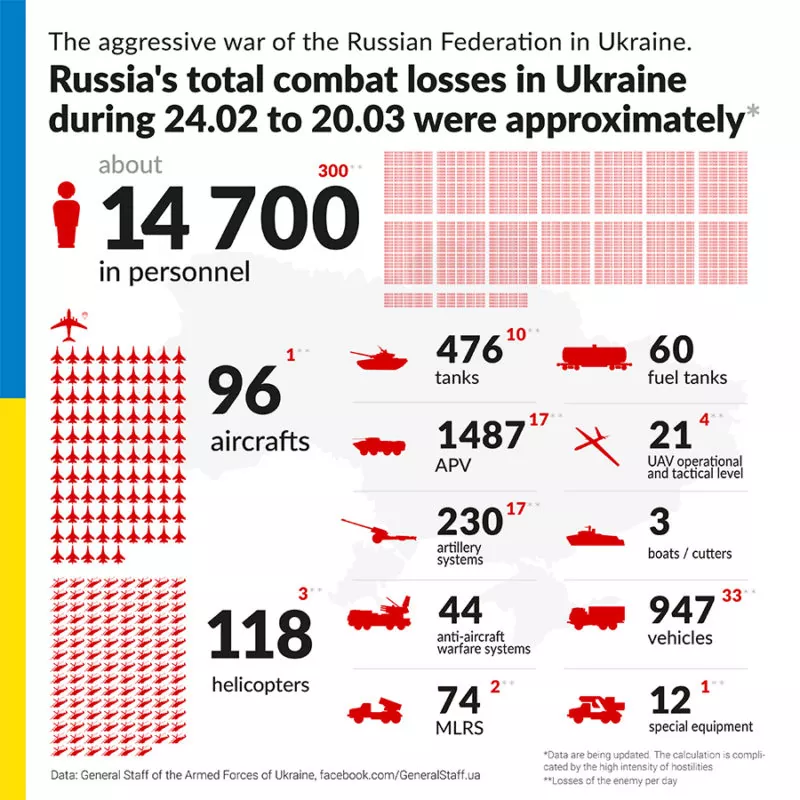
Humanitarian
According to UNHCR 3,328,692 refugees have been registered as of 18 March.
The UN says that so far Poland has taken in 2,010,693 refugees, Romania 518,269, Moldova 359,056, Hungary 299,273, Slovakia 240,009, Russia 184,563 and Belarus 2,548.
An estimated 1.5 million children have fled Ukraine since the Russian invasion began, UNICEF said in a statement Saturday, AXIOS reports. The organization is urging countries accepting refugees from Ukraine to establish stronger safeguards for children at greater risk of human trafficking. Improving coordination and screening at border crossings could identify children separated from their families before traffickers can take advantage of them. More than 500 unaccompanied children were identified leaving Ukraine and entering Romania as of March 17. Romania is only 1 out of the 7 countries bordering Ukraine. (In my opinion, the actual numbers might be 6-7 times higher (3,000-3,500) if we consider the total numbers of refugees/refugees in Romania.)
7 humanitarian corridors to be opened on March 20, Ukrainska Pravda reports:
- Donetsk Oblast: from Mariupol to Zaporizhzhia. The transport of Mariupol residents to Mangush to Berdiansk and Zaporizhzhia was also organized.
- Kyiv Oblast: from the village of Bobryk to Brovary, from the village of Tarasivka to Brovary, from Borodyanka to Bila Tserkva
- Kharkiv Oblast: humanitarian goods (food, medicine) will be sent from Kharkiv to Vochansk, Rohan and Nova Rohan villages.
Environmental
When predicting the future environmental consequences of the war in Ukraine, we only need to review the consequences of the 8-year long war in Donbas; and multiply these by seventeen. In 2018 the UN Environmental Program reported that:
“… the ongoing armed conflict – one of the bloodiest in Europe since the 1990s Balkans wars – has added another layer of significant and partially irreversible damage to local ecosystems. […]
A year before the war broke out, the region hosted 5,500 industries which produced 4.3 million tons – equivalent to 44 per cent of the country’s emissions.
Due to destruction of production infrastructure and emergency mechanisms, environmental degradation risks have significantly increased.
[…] the Siverskyi (Seversky) Donets River – the most polluted river in Ukraine before the conflict – is a tributary of the Don River, flowing through the neighbouring Russian Federation. Pollution of the 650-mile-long waterway, generated by the conflict, continues to pose health risks for the population living along the Don, for whom the river is the main source of water. Suspension of farming gave weeds and rodent mice space to thrive and reproduce, further endangering public health.
“Donbas is on the precipice of an ecological catastrophe fuelled by air, soil and water pollution from the combustion of large amounts of ammunition in the fighting and flooding at industrial plants. […]
According to an assessment carried out by UN Environment’s Science-Policy Platform on Environment and Security, the conflict has affected, damaged, or destroyed ecosystems within an area of at least 530,000 hectares, including 18 nature reserves covering an area of 80,000 hectares. Furthermore, 150,000 hectares of forests have been impacted, with 12,500 forest fires blazing through the military operations zone and adjacent areas.
In 2014 alone, the lack of forest protection and the fighting led to the near irreversible destruction of 479 hectares of forests. […] The military operations zone has also been contaminated by unexploded ordnance whose elimination could take years or decades, based on the experience of other countries such as Bosnia and Herzegovina, Serbia, and Macedonia.”
Devastating as that is, the report did not cover the full extent of the environmental risks and damages. A report from the Centre for Humanitarian Dialogue from October 2017, concluded that:
“The presence of over 4,000 potentially hazardous sites in a heavily urbanised area (which, prior to the conflict, was home to some 7 million people) means that a looming environmental catastrophe could be virtually impossible to control, given the amplifying power of winds, water flows, and the interconnectedness of mines. […]
On top of an already precarious ecological balance in Donbas there are several other looming risks. Coal mines throughout Donbas continue to be abandoned and flooded (rather than systematically pumped in a controlled manner), leading to further underground water and soil contamination affecting both the access to potable water and the area’s suitability for agricultural activities. Ongoing fighting runs the risk of mines being seriously damaged, causing uncontrolled flooding and the leakage of toxic and/or radioactive substances. Unchecked and unfiltered industrial waste is increasingly accumulating in many of the riverbeds of Donbas, creating large-scale health hazards for local inhabitants. Finally, the armed conflict introduces the serious risk that an exchange of shells or mortars may hit sites across the dense concentration of chemical and steel-processing industrial facilities along both sides of the line of contact. This could cause toxic fumes and leachate to contaminate the water, air, and soil in the region.”
Legal
According to the Ukrainian General Staff, In addition, in the temporarily occupied territory of Donetsk Oblast, Russian curators announced another wave of mobilization to replenish the 1st Army Corps. The maximum age of the demobilized has been raised to 65 years. The same is expected for the TOT of Luhansk Oblast, given that trucks filled with killed in actions soldiers arrive daily from the area of the 2nd Army Corps to the settlements of Luhansk, Sorokyne, and Dovzhanske.
Russian terrorist forces continue to violate openly International Conventions on the Rules of War. The facts of using the uniform of the Armed Forces of Ukraine to carry out subversive and discrediting actions by Russian saboteurs are being recorded.
Russian forces have killed 112 Ukrainian children so far. More than 140 children were injured. The actual number is most likely much higher.
To date, 489 educational institutions have been damaged by bombing and shelling, 69 of which have been completely destroyed, according to the Commissioner for Human Rights of the Verkhovna Rada of Ukraine. These data are not conclusive due to the inability to inspect the locations of institutions where active hostilities are taking place and in the temporarily occupied territories.
Since the beginning of Russia's invasion of Ukraine, the Office of the Commissioner for Human Rights has been receiving complaints from Ukrainians about sexual crimes committed by the Russian military.
Support
Australia has developed an additional $21 million support package of defensive military assistance for the Ukrainian Armed Forces. Following discussions between the Australian
Prime Minister and the Minister for Defence and their Ukrainian counterparts, it is clear that Ukraine’s need for military assistance remains urgent and ongoing. To meet Ukrainian priority requests, this package will comprise additional material from Australian Defence Force stocks.
West shifting from sanctions to Ukrainian military aid as the war intensifies, Global News (CA) reports. “As the war in Ukraine becomes increasingly brutal, with Russian attacks killing and displacing civilians, experts say the international community is shifting its focus from sanctions to helping the Ukrainian military. That’s partly because the few remaining options that could have a significant impact on Russia’s economy — namely, a European ban on Russian oil and gas — are not feasible in the short term. It’s also becoming clearer that the sanctions, while devastating, are not swaying Russian President Vladimir Putin. It’s not hurting (Russia) enough to make them stop,” said James Brander, a professor in international business and public policy at the University of British Columbia’s Sauder School of Business.”
“Poland proposes to add a trade blockade to the existing package of sanctions as soon as possible, Ukrinform reports. “This means seaports, that is, a ban from entering ports for vessels flying a Russian flag, carrying Russian goods, as well as ban on trade by land. Warsaw supports the actions of protesters who have been blocking the movement of Russian and Belarusian trucks on the Polish-Belarusian border on Saturday, March 19. Poland’s Prime Minister Mateusz Morawiecki said.”
New developments
- Talks between Moscow and Kyiv on thin ice, DW reports. The war in Ukraine continues to rage while Ukrainian and Russian negotiators talk. “Experts say that for now, neither side is ready for a breakthrough and fear that the war will last a very long time. So far, to no avail. Russian President Vladimir Putin has said that he will not give up his "plan" until his key demands are met: "demilitarization," "denazification," as well as a "neutral status" for Ukraine. He has also called on Kyiv to recognize Crimea as Russian territory, as well as the independence of the "people's republics" of Donetsk and Luhansk. For his part, Ukrainian President Volodymyr Zelenskyy has shown willingness to concede that Ukraine will not become a member of NATO.”
- President Zelensky defiantly told Moscow the time had come for “meaningful negotiations on peace” as a barrage of Russian attacks continued across his nation over the weekend, the Washington Post reports. “It’s time to meet. Time to talk. He added that it was “time to restore territorial integrity and justice for Ukraine. Otherwise, Russia’s losses will be so huge that several generations will not be enough to rebound.”
- Russia expects that the special operation in Ukraine will end with the signing of comprehensive documents on security issues, the neutral status of Ukraine, Foreign Minister Lavrov said. Poland's idea of NATO peacekeepers in Ukraine is according to Lavrov, manipulative. He believes that "the initiative to bring NATO peacekeepers to Ukraine may involve Poland's de facto control over the western part of the country”, Ukrainska Pravda reports. Russia's foreign minister said Russia had attacked Ukraine to thwart “the West's anti-Russian project”.
- Putin is not yet ready to meet Zelensky as he likely wants more war gains, the Times of Israel reports. “As fighting in Ukraine raged on and amid murmurs of a potential ceasefire, a senior Turkish official said Thursday that Russian President Vladimir Putin is not ready yet to meet for talks with his Ukrainian counterpart Volodymyr Zelensky. Zelensky is ready to meet, but Putin thinks that the positions to have this meeting at the leaders’ level are not close enough yet,” Ibrahim Kalin, a chief adviser and spokesman for Turkish President Recep Tayyip Erdogan, told The New York Times”.
- US officials confirmed to CNN that Russia launched hypersonic missiles against Ukraine last week, the first known use of such missiles in combat. The US was able to track the launches in real-time, the sources said. The launches were likely intended to test the weapons and send a message to the West about Russian capabilities, multiple sources told CNN.
Assessment
The Institute for the Study of War has made the following brilliant assessment as of Saturday, March 19, 21:00 (Kyiv time):
The ultimate fall of Mariupol is increasingly unlikely to free up enough Russian combat power to change the outcome of the initial campaign dramatically. Russian forces concentrated considerable combat power around Mariupol drawn from the 8th Combined Arms Army to the east and from the group of Russian forces in Crimea to the west. Had the Russians taken Mariupol quickly or with relatively few losses they would likely have been able to move enough combat power west toward Zaporizhzhia and Dnipro to threaten those cities. The protracted siege of Mariupol is seriously weakening Russian forces on that axis, however. The confirmed death of the commander of the Russian 150th Motorized Rifle Division likely indicates the scale of the damage Ukrainian defenders are inflicting on those formations. The block-by-block fighting in Mariupol itself is costing the Russian military time, initiative, and combat power. If and when Mariupol ultimately falls the Russian forces now besieging it may not be strong enough to change the course of the campaign dramatically by attacking the west.
Russian forces in the south appear to be focusing on a drive toward Kryvyi Rih, presumably to isolate and then take Zaporizhzhia and Dnipro from the west but are unlikely to secure any of those cities in the coming weeks if at all. Kryvyi Rih is a city of more than 600,000 and heavily fortified according to the head of its military administration. Zaporizhzhia and Dnipro are also large. The Russian military has been struggling to take Mariupol, smaller than any of them, since the start of the war with more combat power than it is currently pushing toward Kryvyi Rih. The Russian advance on that axis is thus likely to bog down as all other Russian advances on major cities have done.
The Russian military continues to commit small groups of reinforcements to localized fighting rather than concentrating them to launch new large-scale operations. Russia continues to commit units drawn from its naval infantry from all fleets, likely because those units are relatively more combat-ready than rank-and-file Russian regiments and brigades. The naval infantry belonging to the Black Sea Fleet is likely the largest single pool of ready reserve forces the Russian military has not yet committed. Much of that naval infantry has likely been embarked on amphibious landing ships off of the Odesa coast since early in the war, presumably ready to land near Odesa as soon as Russian forces from Crimea secured a reliable ground line of communication (GLOC) from Crimea to Odesa. The likelihood that Russian forces from Crimea will establish such a GLOC in the near future is becoming remote, however, and the Russian military has apparently begun using elements of the Black Sea Fleet naval infantry to reinforce efforts to take Mariupol.
The culmination of the initial Russian campaign is creating conditions of stalemate throughout most of Ukraine. Russian forces are digging in around the periphery of Kyiv and elsewhere, attempting to consolidate political control over areas they currently occupy, resupplying and attempting to reinforce units in static positions, and generally beginning to set conditions to hold in approximately their current forward positions for an indefinite time. Maxar imagery of Russian forces digging trenches and revetments in Kyiv Oblast over the past several days supports this assessment. Comments by Duma members about forcing Ukraine to surrender by exhaustion in May could reflect a revised Russian approach to ending this conflict on terms favorable to Moscow.
The stalemate will likely be very violent and bloody, especially if it protracts. Stalemate is not an armistice or ceasefire. It is a condition in the war in which each side conducts offensive operations that do not fundamentally alter the situation. Those operations can be very damaging and cause enormous casualties. The World War I battles of the Somme, Verdun, and Passchendaele were all fought in conditions of stalemate and did not break the stalemate. If the war in Ukraine settles into a stalemate condition Russian forces will continue to bomb and bombard Ukrainian cities, devastating them and killing civilians, even as Ukrainian forces impose losses on Russian attackers and conduct counterattacks of their own. The Russians could hope to break Ukraine’s will to continue fighting under such circumstances by demonstrating Kyiv’s inability to expel Russian forces or stop their attacks even if the Russians are demonstrably unable to take Ukraine’s cities. Ukraine’s defeat of the initial Russian campaign may therefore set conditions for a devastating protraction of the conflict and a dangerous new period testing the resolve of Ukraine and the West. Continued and expanded Western support to Ukraine will be vital to seeing Ukraine through that new period.
Key Takeaways:
- We now assess that the initial Russian campaign to seize Ukraine’s capital and major cities and force regime change has failed;
- Russian forces continue efforts to restore momentum to this culminated campaign, but those efforts will likely also fail;
- Russian troops will continue trying to advance to within effective artillery range of the center of Kyiv, but prospects for their success are unclear;
- The war will likely descend into a phase of bloody stalemate that could last for weeks or months;
- Russia will expand efforts to bombard Ukrainian civilians in order to break Ukrainians’ will to continue fighting (at which the Russians will likely fail);
- The most dangerous current Russian advance is from Kherson north toward Kryvyi Rih in an effort to isolate Zaporizhzhia and Dnipro from the west. Russian forces are unlikely to be able to surround or take Kryvyi Rih in the coming days, and may not be able to do so at all without massing much larger forces for the effort than they now have available on that axis;
- The Russians appear to have abandoned plans to attack Odesa at least in the near term.”

